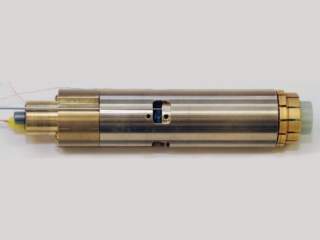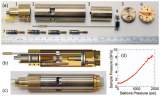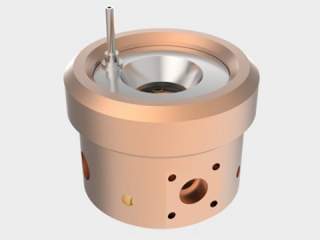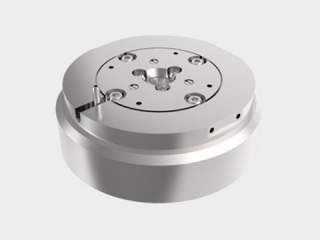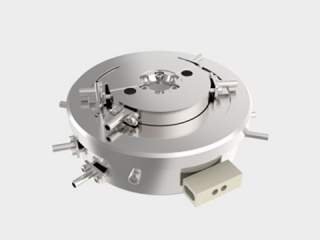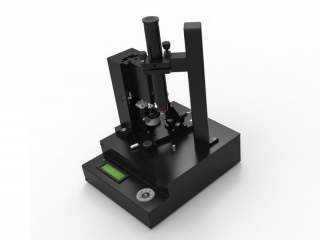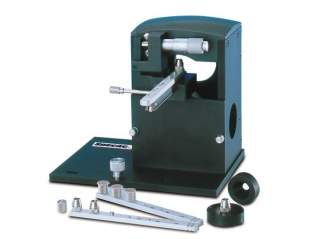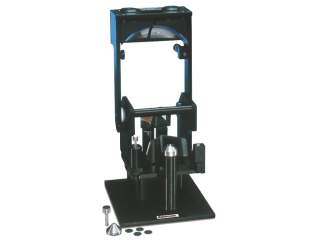Diacell ChicagoDAC Patterned Diamond Anvil
A compact bellows-driven diamond anvil cell for high-pressure, low-temperature transport measurements
Introduction
A key capability for efficiently studying materials at low temperature and under pressure is the ability to vary and measure the pressure without needing to warm the system to room temperature. In this DAC design, pressure tuning is enabled by incorporating a custom bellows actuator (316 stainless steel, BellowsTech Inc.) pressurized with helium via a capillary line connected to a room-temperature gas reservoir and manifold. The bellows sits below the pressure chamber in the cell assembly with the capillary line for pressurizing the bellows passing through an access hole in the cell body.
Electrical transport experiments play a key role in the study of many interesting high pressure phenomena, including pressure-induced superconductivity, insulator-to-metal transitions, and quantum critical behavior. High-pressure electrical transport experiments also play an important function in geophysics and Earth’s interior studies.
The ChicagoDAC is an efficient bellows-controlled diamond anvil cell that is optimized for use in the Quantum Design PPMS platform, but it can be equally adapted to fit inside the bores of high-field superconducting magnets in helium-4 cryostats (with or without liquid helium), helium-3 cryostats, and dilution refrigerators.
A compact bellows-driven diamond anvil cell for high-pressure, low-temperature transport measurements
The Diacell® ChicagoDAC was developed in full collaboration with the group of Prof. Rosenbaum - then at the University of Chicago; now at Caltech. The principle of operation of the cell is described in detail on Feng, et al. Rev. Sci. Instr. 85, 033901 (2014).
The ChicagoDAC is an efficient bellows-controlled diamond anvil cell that is optimized for use in the Quantum Design PPMS platform, but it can be equally adapted to fit inside the bores of high-field superconducting magnets in helium-4 cryostats (with or without liquid helium), helium-3 cryostats, and dilution refrigerators.
The diamond anvil cell is non-magnetic and provides in situ pressure tuning and measurement by means of a helium-filled bellows actuator and fiber-coupled ruby fluorescence spectroscopy, respectively. An insert is available to accommodate the gas coupling to the bellows and the necessary optics for ruby fluorescence manometry. For the latter, in particular, a single multimode optical fiber carrying both the incident light and the emitted spectrum coupled to a pair of plano-convex lenses provide a wide-aperture coupling between the fiber and the pressure chamber. This efficient coupling allows the cell pressure to be measured with incident light power in the tens or hundreds of μW range, minimizing any local heating that might occur during the measurement.
As such, the ChicagoDAC provides an opportunity to probe a variety of phenomena continuously and with high resolution in the three-dimensional high-magnetic-field, high-pressure and low-temperature parameter space.
Features
A key capability for efficiently studying materials at low temperature and under pressure is the ability to vary and measure the pressure without needing to warm the system to room temperature. In this DAC design, pressure tuning is enabled
by incorporating a custom bellows actuator (316 stainless steel, BellowsTech Inc.) pressurized with helium via a capillary line connected to a room-temperature gas reservoir and manifold. The bellows sits below the pressure chamber in the
cell assembly with the capillary line for pressurizing the bellows passing through an access hole in the cell body.
Diacell® ChicagoDAC Structure
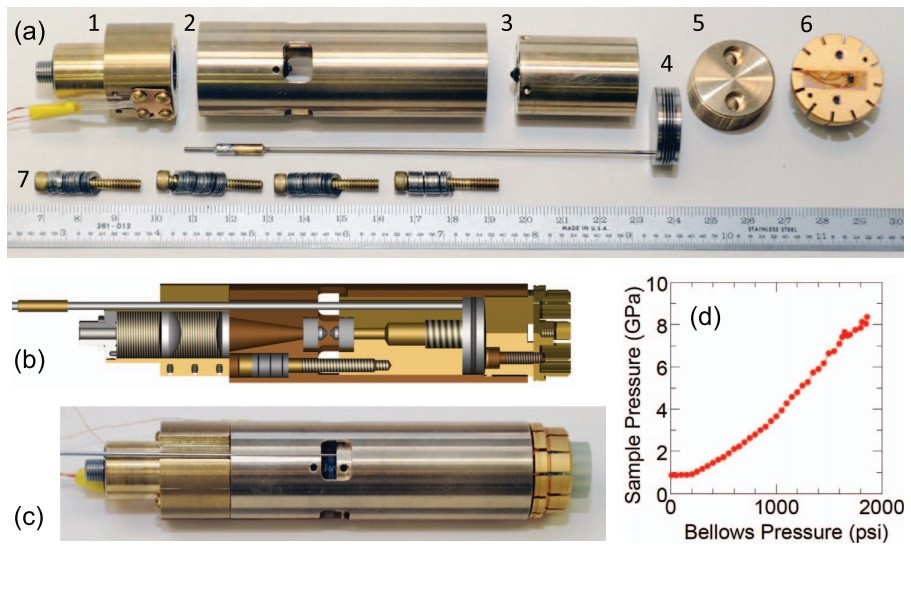
(a) Disassembled cell and its parts
(1) optics mount containing SMA fiber coupler and two plano-convex lenses to couple sample chamber to fiber; a Cernox thermometer is attached to the outside to measure the cell temperature.
(2) Outer cylinder of the cell body. A mounted diamond is visible through the window.
(3) Inner cylinder of the cell body with a second mounted diamond.
(4) Helium bellows actuator.
(5) Plug with external thread to screw into part 1 of the cell body for bellows confinement.
(6) PPMS sample puck for mounting to cryostat base. A GaAs Hall sensor mounted to the puck measures the applied field.
(7) Four brass 6-32 screws with stacks of 302 stainless steel Belleville spring washers (Associated Spring Raymond) for sealing and initial pressurization of cell.
(b) Cross-sectional rendering of the internal structure of the cell.
(c) Photograph of a fully assembled cell. (d) Loading curve of the bellows-actuator at T = 8 K. Pressure is measured using the ruby fluorescence through the fiber optics. Stick-slip motion of the cell is observed at high membrane pressures.
Disassembly / Assembly Video
Applications
One particular exciting application is having the ChicagoDAC equipped with our new development of patterned diamond anvils to enable seamless transport measurements at the extreme conditions. The patterned diamond anvils have electrically conducting tracks deposited on culet and pavilion, which enables making contacts to the sample much easier.
Similarly, susceptibility measurements are equally possible and the paper by Feng et al. referred above gives details on how to pursue that.
Finally, because of suitable optics already present in the ChigagoDAC's insert, other spectroscopic measurements such as fluorescence and inelastic scattering (Raman) are also feasible with the same set-up.


